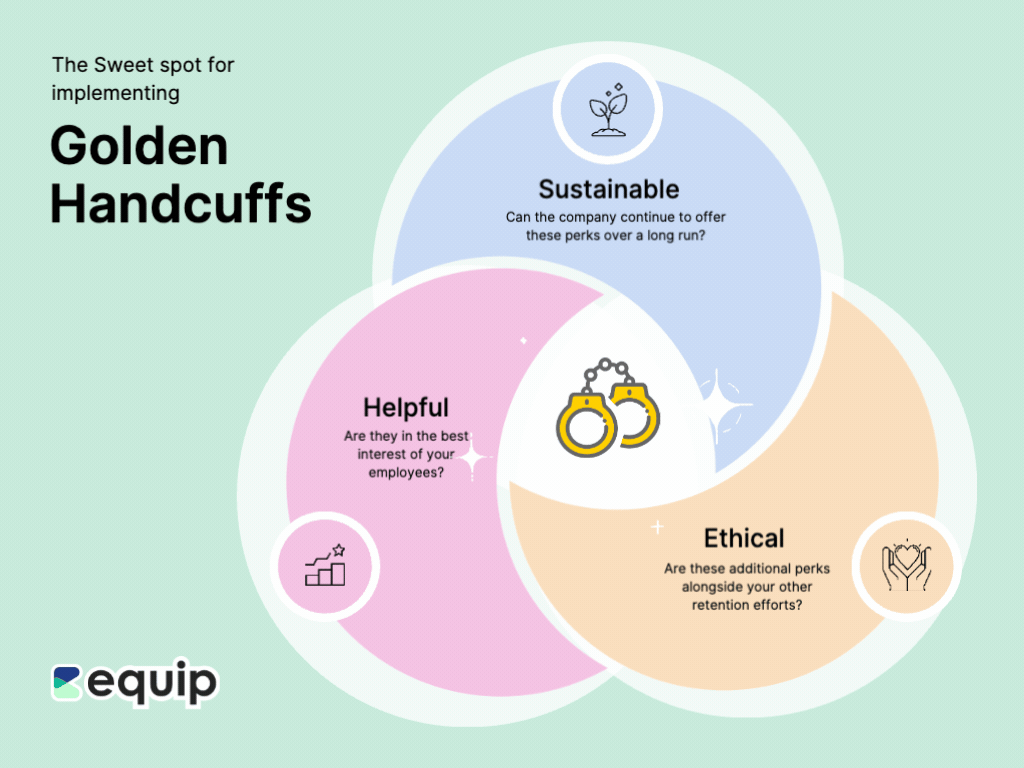
Retention is an age-old issue for HR pros around the world. Whether it’s due to culture issues, poor benefits or low compensation, or an inflexible work environment, employers are always on the lookout to reduce turnover and improve retention.
One way that companies try to entice employees to stay is through targeted incentives, called “golden handcuffs” that entice employees to stay at the organization.
The ethics of golden handcuffs has been debated between HR professionals , but the practice is still relevant across industries. So what exactly does the practice of using “golden handcuffs” to retain employees entail? And are they harmful or truly helpful?
What are Golden Handcuffs?
Put simply, golden handcuffs are added perks companies use to attract and keep employees. Even if employees want to leave, the generous incentives can make them feel trapped or “handcuffed” to their current employer.
The term golden handcuffs originated in 1976 and is closely related to the term “golden handshake”, which was coined just a few years earlier. A golden handshake is an ultra-appealing severance agreement that can push an older employee into retirement, even if they aren’t necessarily ready to leave (Yikes!).
Examples of Popular Golden Handcuffs
These “golden cuffs” can cover a broad range of benefits or incentives, especially ones that are designed to retain employees, such as stocks that take multiple years to vest. Other common types of golden handcuffs are student loan repayment assistance, a company car, or large annual bonuses.
Incentives can be used by employers in several scenarios, like:
- During onboarding
- After a certain number of years, or
- After achieving major milestones
Why employers use Golden Cuffs
Employers use golden handcuffs as a recruitment and retention tool. Top applicants are attracted to the company because of the perks, and the promise of those perks can keep them around rather than starting with a new company. Think of it as corporate prenup— except whose perks are valid while the union of the employer and employee lasts as opposed to claiming them on separation.
Golden cuffs are used for many employees, but they can be targeted to specific groups that employees want to retain, such as:
- High performers
- C-suite executives
- Senior-level employees
- Long-tenured employees
Golden handcuffs are used across various industries but may be used more in industries that need to rely on more than base salary alone to retain employees, such as tech or finance.

Examples of golden handcuffs
Golden handcuffs can be used to describe any type of perk designed to keep employees tied to the company, but there are some common examples of golden handcuffs that are tried and true for employers.
Stock options
Stock options are a common type of perk that can be considered a golden handcuff because many stock options are vested after a number of years. Therefore, employees have an incentive to stick around until their stock is vested.
Company gifts
Whether it’s a vacation home, company car, company phone, or sports tickets, some organizations use company gifts as a way to attract and retain employees. Employees may feel indebted to the company due to the gifts they provide – especially when they’re on the more expensive side – making it hard to leave.
For example, one CEO has promised extravagant gifts like luxury cars – but only if employees stay for five years. The promise of these gifts can keep employees at the company, even if they aren’t feeling fulfilled in their role.
Additional compensation
Whether it be through generous quarterly or annual bonuses or paid vacation time, adding compensation to an employee’s base salary is another form of golden handcuffs.
For example, in 2018, home healthcare business Bayada’s founder gave out $20 million to workers, with gifts ranging from $50 to $10,000 depending on tenure.
Pros and cons for HR
Even just the term “golden handcuffs” implies that it comes with some good and some bad. The practice is controversial for both employers and employees because, while it can boost retention, it’s intended to keep employees around – even if they have the desire to leave.
But are they truly ethical – or beneficial? Here’s what to consider.
Pros of golden handcuffs
Here are the benefits of organizations using golden handcuffs.
- Improves retention: When done right, golden handcuffs can help employers keep employees around longer and help reduce turnover.
- Attracts candidates: Especially during a turbulent economic period, financial incentives can be a powerful recruitment tool.
- Motivates employees: Added perks and benefits can help motivate employees and help them perform better.
Cons of golden cuffs
- Discourages development: Golden handcuffs can stop employee growth and development since they are “trapped” by the golden handcuffs in their current role. CEO William Rochelle described them as “a shiny object to distract from the lack of support and education.”
- Leads to negative consequences: Although golden handcuffs can motivate employees, they can have the opposite effect over time. Many employees end up feeling trapped, despite wanting to make a career change, which can lead to lower morale and satisfaction, burnout, and eventually turnover.
- Can be costly for employers: Depending on company size and budget, extra financial perks that are tethering high-performers can cause them to spend big or risk losing their best people, especially if organizations use luxurious company gifts or large bonuses.
Implementation tips for HR
Golden handcuffs can be a powerful retention tool, but they may not be as effective in the long run. Employees can become resentful and feel devalued by employers who use golden handcuffs to keep them tied to the company.
If an organization decides to implement golden handcuffs, there are some essential tips and best practices HR should consider.
- Use alongside other retention efforts: Golden handcuffs shouldn’t be your only strategy to retain your best employees. Instead, use it alongside other employee retention strategies that speak to employee needs.
- Align incentives with organizational goals: If your goal is to retain employees for a longer period of time, consider using a vesting schedule. But if your goal is to improve employee performance, it might make more sense to provide goal- or performance-based bonuses.
- Don’t ignore development: One of the biggest mistakes organizations can make when using golden handcuffs is using it as a way to ignore employee development and growth, so it’s important to stay proactive about employee development.
- Customize incentives: Incentives that are used as golden handcuffs should be customized to appeal to the specific desires of your workforce instead of a “one size fits all” strategy, which can be less effective. For example, Netflix offers unlimited parental leave, which can be enticing for new or expecting parents. However, it might not add as much value for a workforce that is primarily older workers who wouldn’t use the perk.
- Consider exit strategies: One of the most debated parts of the idea of golden handcuffs is benefits that only kick in after a certain number of years, such as stock options with a longer vesting period. This can make employees feel trapped in the organization until that period hits, so it can be beneficial to plan out what happens to those benefits when employees leave.